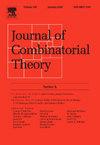具有Ulam度量的置换的直径问题(最优反码)
IF 1.2
2区 数学
Q2 MATHEMATICS
引用次数: 0
摘要
我们研究了在Ulam距离下排列空间中的直径问题(即最优反码问题)。也就是说,令Sn表示n个符号的排列集合,对于每个σ,τ∈Sn,定义它们的Ulam距离为必须从每个符号中删除直至相等的不同符号的数目。在此空间中,我们得到了两个球的交点大小的一个近似最优上界,并作为推论,证明了一个直径不超过k的集合的大小不超过2k+Ck2/3n!/(n−k)!,与最著名的尺寸为n!/(n−k)!的结构相比。本文章由计算机程序翻译,如有差异,请以英文原文为准。
Diametric problem for permutations with the Ulam metric (optimal anticodes)
We study the diametric problem (i.e., optimal anticodes) in the space of permutations under the Ulam distance. That is, let denote the set of permutations on n symbols, and for each , define their Ulam distance as the number of distinct symbols that must be deleted from each until they are equal. We obtain a near-optimal upper bound on the size of the intersection of two balls in this space, and as a corollary, we prove that a set of diameter at most k has size at most , compared to the best known construction of size .
求助全文
通过发布文献求助,成功后即可免费获取论文全文。
去求助
来源期刊
CiteScore
2.90
自引率
9.10%
发文量
94
审稿时长
12 months
期刊介绍:
The Journal of Combinatorial Theory publishes original mathematical research concerned with theoretical and physical aspects of the study of finite and discrete structures in all branches of science. Series A is concerned primarily with structures, designs, and applications of combinatorics and is a valuable tool for mathematicians and computer scientists.

 求助内容:
求助内容: 应助结果提醒方式:
应助结果提醒方式:


